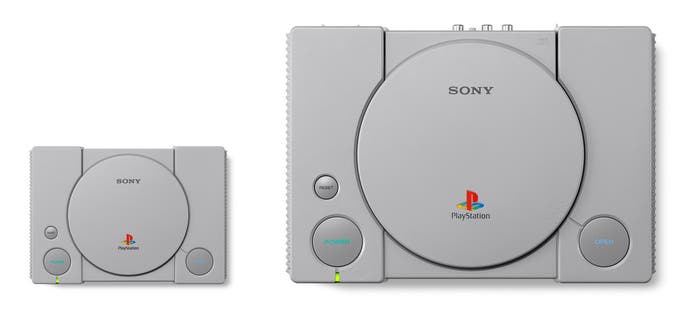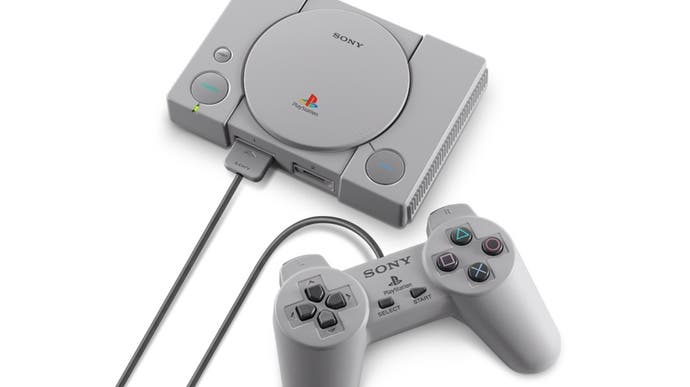We've played the PlayStation Classic, and it's underwhelming
Mediocre emulation and an anaemic list of games - though there's still some magic there.
I first heard of it through a playground rumour; whisperings there was a machine that could run Ridge Racer, the game that had been wowing us all over the summer holidays at whatever low-rent seaside resort our families had dragged us to. And what's more, someone knew a friend of a friend who had one - who'd imported one from Japan and had Namco's polygon-rich racer playable in their own living room.
First contact came that autumn, in a friend's bedroom on a 14-inch CRT that offered a small window into the future with WipEout, and the next few months were spent campaigning to get one for Christmas. And when it finally came, it felt like something else; more than a mere new generation, the first PlayStation marked the beginning of the modern era of gaming.
And so coming face-to-face with one in Sony's offices, all these years later, is an emotional experience, like chancing upon an old friend. Strange how a little grey lump of plastic can prove so powerful to someone of a certain age, though even now looking at the original PlayStation it still looks like a relic from the future. And, just as it is when you return to your hometown after years away, it seems so much smaller than you remembered it.

Then, just next to the original PlayStation, is the PlayStation Classic, which is smaller than you might have imagined it. Some 45 per cent smaller, in fact, although it's perfectly formed, an impressive miniature that looks like one of the originals had been left in a hot wash. It's lighter too, of course, coming in at 170g - though lifting up the original console, it's remarkable how light that feels compared to the unwieldy bricks of today.
The PlayStation Classic's controller, meanwhile, is a 1:1 likeness of the original (and that's the original original, remember - this isn't the DualShock that was introduced in 1997, and as such it lacks rumble and those two analogue sticks). It is ever so slightly lighter in the hand, though that's simply down to the fact there's a slimmer cable protruding from it - and at that cable's end is a USB A connector, itself protruding from a plastic nubbin that perfectly mimics the connector on the original PlayStation controller and that slots neatly into place on the console. It really does all look the part.
The console hardware itself has some neat functionality too. Around the back it's powered by micro-USB, and there's a single HDMI out, while on the top of the console the three buttons are all put to use. The power button is self-explanatory. The reset button throws you out of any particular game and into the PlayStation Classic's main menu, while the eject button is used to change discs in games that are split across several CD-ROMs, such as Final Fantasy 7.

As a piece of simple engineering, then, the PlayStation Classic is a triumph; a perfectly adorable, shrunken down version of the original that would look just splendid on your shelf. It's only really when you plug it in to play that things start to fall apart a little. The front-end is responsive if not exactly attractive - though its graphical stylings are at least period correct for the mid-90s games it's hosting. There are next to no options - you'll have the ability to enable a screensaver, tinker with power saving modes and language and... That's it. There are no screen filters, and nothing to try and soothe the transition of these games onto TVs that they were never designed for.
The output is 720p, a logical enough choice given the majority of the games here are 244p and upscale fairly cleanly with small black borders either side of the image, but it can't hide the fact that something feels off about how these games look and play. Getting the relatively crude 3D work of original PlayStation games to play nicely on modern displays was always going to be a tougher task than that faced than by Nintendo with its previous 2D-dominated Classic consoles, but the soft scaling doesn't help its cause, and there's noticeable lag - minimally so when playing a 30fps game such as Ridge Racer Type 4, but much more pronounced in 60fps games such as Mr. Driller or Tekken 3. They feel soupy in the hand - though that's as much the fault of modern displays compared to the more responsive CRTs these games were designed for than anything else.
Some problems are more specific to the PlayStation Classic, though again they're ones you can't necessarily blame Sony for. The game selection is, to put it politely, anaemic, with titles that made PlayStation a household name - WipEout, Gran Turismo, Tomb Raider - entirely absent. Part of the problem is also part of the original PlayStation's pioneering; as arguably the first console of the modern era, it's also one of the first bogged down with issues of licensing when it comes to music tracks brought in from elsewhere, or in the case of Gran Turismo with auto manufacturers. Getting hold of those licences again could be a pain - in some cases, it's an impossibility.
The result, though, is that next to the stellar line-ups of the NES Classic and SNES Classic, it all feels underwhelming, and not exactly representative of the original PlayStation in its prime. This is, at best, a functional take on the mini-console phenomenon, and a cute stocking filler for the coming Christmas period - even if the price doesn't quite reflect that. It most certainly is not a decent emulator, and far from the best way to play this (limited) selection of games.
For all that, though, and for the disappointing feeling that the PlayStation Classic is something of a missed opportunity, there's still magic to be found here. Having messed around disapprovingly with the menus, I settled after an hour or so on Jumping Flash, that bizarre first-person platformer that has always sat awkwardly, brilliantly, between the soft abstraction of 16-bit games and the more recognisable, harder edges that the PlayStation was about to usher in, and all of a sudden I'm transported back to Christmas Day, 1995, and am filled with that same sense of wide-eyed wonder. The PlayStation Classic is far from perfect, then, a slightly murky window onto a historically important machine, but for all the missteps taken here, the original brilliance still manages to occasionally shine through.










